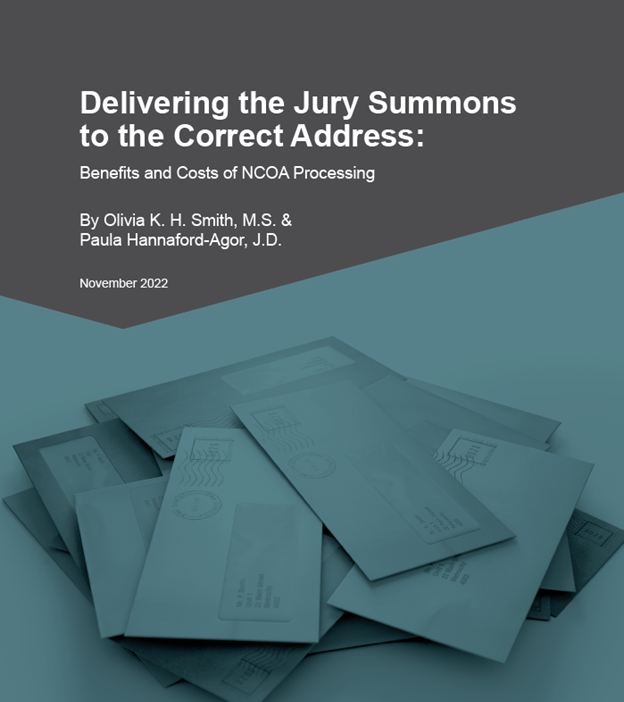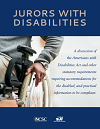NCSC's Center for Jury Studies has more than 30 years' experience advising state and federal courts on effective jury system management, including summoning and qualification procedures, juror orientation, jury system automation and jury trial practices.
 The right to trial by jury is a fundamental pillar of the American justice system that ensures that justice is administered not by the elite but by all citizens who bring their values and perspectives into the courtroom. Despite their time-honored importance, juries and jury trials are facing unprecedented challenges. In 2024, NCSC convened a 2-day workshop with justice system stakeholders, including state and federal judges, court administrators and jury managers, criminal and civil trial lawyers, business and community organizations, and academic scholars. Their discussions identified four areas of weakness in the contemporary jury system that threaten its continued vitality as a cornerstone of democracy and the rule of law. Preserving the Future of Juries and Jury Trials describes these vulnerabilities and proposes concrete strategies to address them.
The right to trial by jury is a fundamental pillar of the American justice system that ensures that justice is administered not by the elite but by all citizens who bring their values and perspectives into the courtroom. Despite their time-honored importance, juries and jury trials are facing unprecedented challenges. In 2024, NCSC convened a 2-day workshop with justice system stakeholders, including state and federal judges, court administrators and jury managers, criminal and civil trial lawyers, business and community organizations, and academic scholars. Their discussions identified four areas of weakness in the contemporary jury system that threaten its continued vitality as a cornerstone of democracy and the rule of law. Preserving the Future of Juries and Jury Trials describes these vulnerabilities and proposes concrete strategies to address them.
 NCSC and RTI, in collaboration with Strengthening the Sixth partners, the Association of Prosecuting Attorneys, and the National Association for Criminal Defense Lawyers, conducted a study to better understand the reasons behind jurors' nonresponse and failure to appear in court in Harris County, Texas. This project, supported by a grant from the Bureau of Justice Assistance, used surveys and interviews to identify challenges faced by jurors, ranging from delayed summonses to barriers to service. The study's findings, summarized in this report, provide practical recommendations to address these issues and enhance juror participation and engagement. These findings were discussed in further depth in the accompanying webinar: "Why Won't They Come?".
NCSC and RTI, in collaboration with Strengthening the Sixth partners, the Association of Prosecuting Attorneys, and the National Association for Criminal Defense Lawyers, conducted a study to better understand the reasons behind jurors' nonresponse and failure to appear in court in Harris County, Texas. This project, supported by a grant from the Bureau of Justice Assistance, used surveys and interviews to identify challenges faced by jurors, ranging from delayed summonses to barriers to service. The study's findings, summarized in this report, provide practical recommendations to address these issues and enhance juror participation and engagement. These findings were discussed in further depth in the accompanying webinar: "Why Won't They Come?".
 The NCSC Center for Jury Studies recently published a study of inclusiveness, representativeness, and accuracy for master jury lists in three states. The study found that NCOA processing updated an average of 10% of address records across six different juror source lists. In a follow-up effort, the NCSC Center for Jury Studies issued a Request for Information (RFI) to NCOA authorized vendors seeking information about the cost of services and the availability of supplemental services for hypothetical courts with different volumes of record processing. A report summarizing RFI responses from 13 NCOA Providers shows the potential savings for courts for printing, postage and staff costs and highlights considerations for choosing between vendor services.
The NCSC Center for Jury Studies recently published a study of inclusiveness, representativeness, and accuracy for master jury lists in three states. The study found that NCOA processing updated an average of 10% of address records across six different juror source lists. In a follow-up effort, the NCSC Center for Jury Studies issued a Request for Information (RFI) to NCOA authorized vendors seeking information about the cost of services and the availability of supplemental services for hypothetical courts with different volumes of record processing. A report summarizing RFI responses from 13 NCOA Providers shows the potential savings for courts for printing, postage and staff costs and highlights considerations for choosing between vendor services.
 The master jury list is the first step in the complex process of assembling a pool of prospective jurors. To ensure that the process is efficient and that the resulting jury pool reflects the demographic composition of the community, the master jury list should be broadly inclusive of the adult population, geographically and demographically representative, and contain accurate address records. In 2021, the NCSC Center for Jury Studies undertook a study of juror source lists and master jury lists in three states. The final report highlights the implications of using poor quality juror source lists and failing to identify duplicate records during process of merging multiple lists, which resulted in substantially over-inclusive source lists and master jury lists in all three states. The NCSC concluded that over-inclusiveness can be as problematic as under-inclusiveness. The presence of unrecognized duplicate records and stale records undermines the efficiency of the jury system by incurring printing, postage, and staffing costs for duplicative jury summonses or summonses that do not reach the intended recipients. It also distorts demographic representation in different ways. In some states, it may mask underrepresentation of racial and ethnic groups; in others, it may cause concerns about underrepresentation that does not really exist. The NCSC recommended that state courts use only as many juror source lists as necessary to achieve inclusiveness at or near 100%. The choice of which source lists to use should be based on assessments of list quality, especially concerning record accuracy, which may differ from state to state.
The master jury list is the first step in the complex process of assembling a pool of prospective jurors. To ensure that the process is efficient and that the resulting jury pool reflects the demographic composition of the community, the master jury list should be broadly inclusive of the adult population, geographically and demographically representative, and contain accurate address records. In 2021, the NCSC Center for Jury Studies undertook a study of juror source lists and master jury lists in three states. The final report highlights the implications of using poor quality juror source lists and failing to identify duplicate records during process of merging multiple lists, which resulted in substantially over-inclusive source lists and master jury lists in all three states. The NCSC concluded that over-inclusiveness can be as problematic as under-inclusiveness. The presence of unrecognized duplicate records and stale records undermines the efficiency of the jury system by incurring printing, postage, and staffing costs for duplicative jury summonses or summonses that do not reach the intended recipients. It also distorts demographic representation in different ways. In some states, it may mask underrepresentation of racial and ethnic groups; in others, it may cause concerns about underrepresentation that does not really exist. The NCSC recommended that state courts use only as many juror source lists as necessary to achieve inclusiveness at or near 100%. The choice of which source lists to use should be based on assessments of list quality, especially concerning record accuracy, which may differ from state to state.
 One of the many reasons that jurors deserve recognition during Juror Appreciation Week is their dedication to doing fair and impartial justice for very little monetary reward. Some states have become increasingly aware of the financial barriers that impede full participation, especially for people working in hourly-wage jobs, and have made efforts to increase juror compensation. A new report documents existing and proposed juror compensation in state courts. Be sure to also check out our Comparative Data web page that shows the size of the gap between juror compensation and median per capita income in each state, as well as the length of time since jurors got a raise.
One of the many reasons that jurors deserve recognition during Juror Appreciation Week is their dedication to doing fair and impartial justice for very little monetary reward. Some states have become increasingly aware of the financial barriers that impede full participation, especially for people working in hourly-wage jobs, and have made efforts to increase juror compensation. A new report documents existing and proposed juror compensation in state courts. Be sure to also check out our Comparative Data web page that shows the size of the gap between juror compensation and median per capita income in each state, as well as the length of time since jurors got a raise.
 This updated briefing paper summarizes recent studies on the impact of jury size on the demographic composition of juries, the accuracy and reliability of verdicts, and operational efficiency and cost-effectiveness. New insights from empirical research highlight the interrelationship of jury size and unanimous verdict rules on the dynamics of jury deliberations.
This updated briefing paper summarizes recent studies on the impact of jury size on the demographic composition of juries, the accuracy and reliability of verdicts, and operational efficiency and cost-effectiveness. New insights from empirical research highlight the interrelationship of jury size and unanimous verdict rules on the dynamics of jury deliberations.

Jury System Management (NCSC 2006)

Does Jury Size Matter? A Review of the Literature (August 2004)
Jury Scams
Outreach to Prevent Jury Scams (2015)
Copyright
How Copyright Law Impacts Movies as Entertainment in Jury Assembly Rooms (2014)
2-Step to 1-Step Conversion
Tripping over our Own Feet: In Jury Operations, Two Steps are One Too Many (2010)
Undeliverable Summonses
Non-Response/Failure to Appear
Why Won't They Come? (2023)
Tales of "Tales" Juries (2008)
Improving Citizens Response to Jury Summons (1999)
More on Dealing with Non-Responders (1997)
What to Do, Oh What to do with Persons Who Don't Answer the Summons? (1995)
Term of Service
A New Look at Term of Service (2007)
Orientation
Conduct an Effective Jury Orientation — Because First Impressions Are Always Lasting (2013)
What Can We Say in Juror Orientations? (2004)
What Should a Modern Juror Assembly Room Look Like? (1995)
Juror Compensation
Using Debit Cards to Pay Jurors (2017)
The Laborer is Worthy of his Hire and Jurors are Worthy of their Juror Fees (2006)
Free Public Transportation for Jurors (1996)
Security
Court Security Includes Jurors, Too (2009)
Court Security Discussions Should Include Juror Security (2005)
Community Outreach
Jury Service: Good for the Justice System, Good for the Community (2006)
Juror Community Awareness Programs (1995)
Miscellaneous
What Were They Thinking? (2024)
AaaaaCHOOO! What's your plan for dealing with the coming flu pandemic? (2007)




